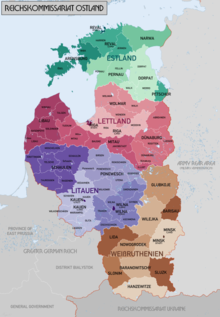Generalbezirk Estland
 From Wikipedia the free encyclopedia
From Wikipedia the free encyclopedia
Generalbezirk Estland (General District Estonia) was one of the four administrative subdivisions of Reichskommissariat Ostland, the 1941-1944 civilian occupation regime established by Nazi Germany for the administration of the three Baltic countries (Estonia, Latvia and Lithuania) and the western part of the Byelorussian SSR.
Organization and Structure[edit]
Generalbezirk Estland was the last of the four districts to be formally established on 5 December 1941.[1] It was organized on the territory of German-occupied Estonia, which had until then been under the military administration of the Wehrmacht's Army Group North. The capital of Generalbezirk Estland was Tallinn (Reval).[2]
Administrative divisions[edit]

Generalbezirk Estland had the following seven subdivisions called Kreisgebiete (County Areas). The seat of administration is in parentheses.[3]
- Arensburg (Kuressaare)
- Dorpat (Tartu)
- Narwa (Rakvere)
- Pernau (Pärnu)
- Petschur (Pechory)
- Reval-Stadt (Tallinn)
- Reval-Land (Paide)
Civil and Police Leadership[edit]
Civil administration was led by a Generalkommissar (General Commissioner) directly appointed by Adolf Hitler, and who reported to Ostland Reichskommissar Hinrich Lohse, headquartered in Riga.[4] In addition, police and security matters were overseen by an SS and Police Leader (SSPF) directly appointed by Reichsführer-SS Heinrich Himmler, and who reported to the Higher SS and Police Leader (HSSPF) Ostland und Russland-Nord in Riga, SS-Gruppenführer Hans-Adolf Prützmann until 1 November 1941, and SS-Obergruppenführer Friedrich Jeckeln after that date.[5]
- Generalkommissar: Karl-Siegmund Litzmann (5 December 1941 – 17 September 1944).[6]
- SS and Police Leader: SS-Brigadeführer Hinrich Möller (4 August 1941 – 1 April 1944); SS-Brigadeführer Walther Schröder (1 April 1944 – 19 October 1944).[7]
Holocaust[edit]
Following the German invasion in June 1941, the death squads of Einsatzgruppe A and their Estonian collaborators immediately began the systematic murder of Estonian Jews. Approximately 75% of Estonian Jews had fled eastward into the Soviet Union ahead of the Nazi occupation. Virtually all of those who remained (between 950 and 1,000 people) were murdered. The Estonian International Commission for Investigation of Crimes Against Humanity estimated the total number of victims killed in Estonia to be roughly 35,000, including approximately 1,000 Estonian Jews, 10,000 foreign Jews, 1000 Estonian Romani, 7000 ethnic Estonians and 15,000 Soviet prisoners of war.[8]
Dissolution[edit]
On 17 September 1944, the Red Army launched the Tallinn offensive and Litzmann departed for Hungary. The city was abandoned by the German forces on 22 September and fell to the Soviets, who captured the rest of mainland Estonia by 26 September and Generalbezirk Estland effectively ceased to exist. Administration of those parts of Estonia still under German occupation reverted to military administration under Army Group North.
See also[edit]
References[edit]
- ^ "Estonian Administrator Named". New York Times. 7 December 1941. p. 66.
- ^ Generalbezirk Estland in Territorial changes in Germany and German administered areas, 1874-1945 Retrieved 26 May 2022.
- ^ Generalbezirk Estland in Territorial changes in Germany and German administered areas, 1874-1945 Retrieved 26 May 2022.
- ^ Miller, Michael D.; Schulz, Andreas (2017). Gauleiter: The Regional Leaders of the Nazi Party and Their Deputies, 1925–1945, Volume 2 (Georg Joel - Dr. Bernhard Rust). R. James Bender Publishing. p. 249. ISBN 978-1-932-97032-6.
- ^ Yerger, Mark C. (1997). Allgemeine-SS : the commands, units, and leaders of the General SS. Atglen, PA: Schiffer Pub. pp. 23, 44. ISBN 0-7643-0145-4.
- ^ Miller & Schulz 2017, p. 249.
- ^ Yerger 1997, pp. 58–59.
- ^ "Report Phase II: The German Occupation of Estonia 1941–1944" (PDF). Estonian International Commission for Investigation of Crimes Against Humanity. 1998. Archived from the original (PDF) on July 20, 2011. Retrieved June 15, 2016.